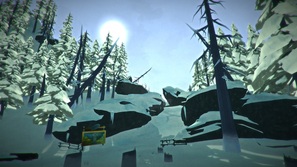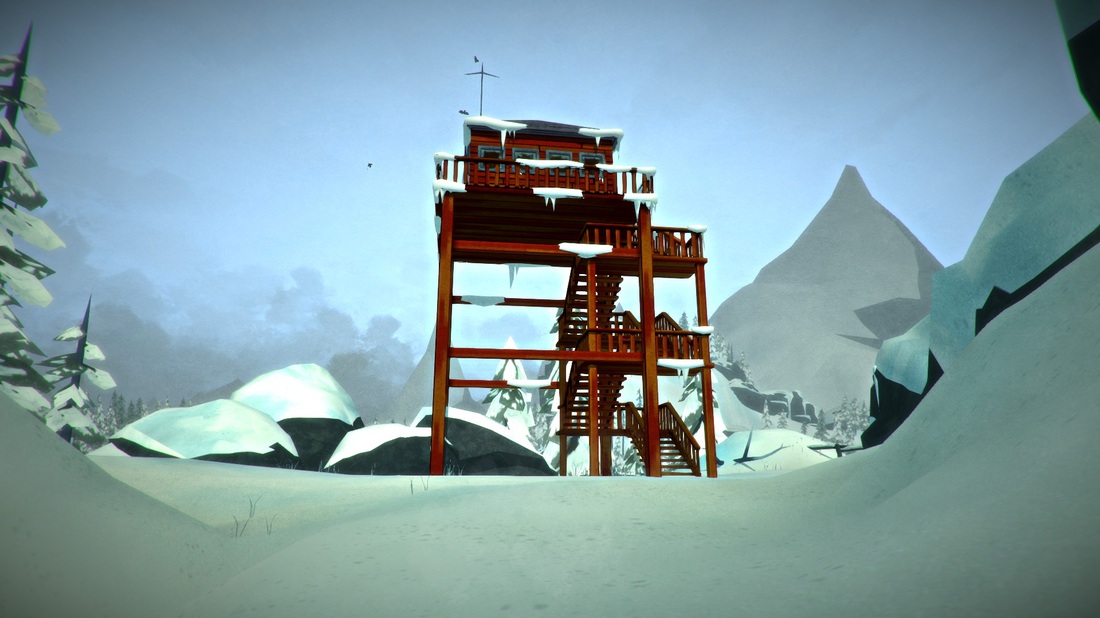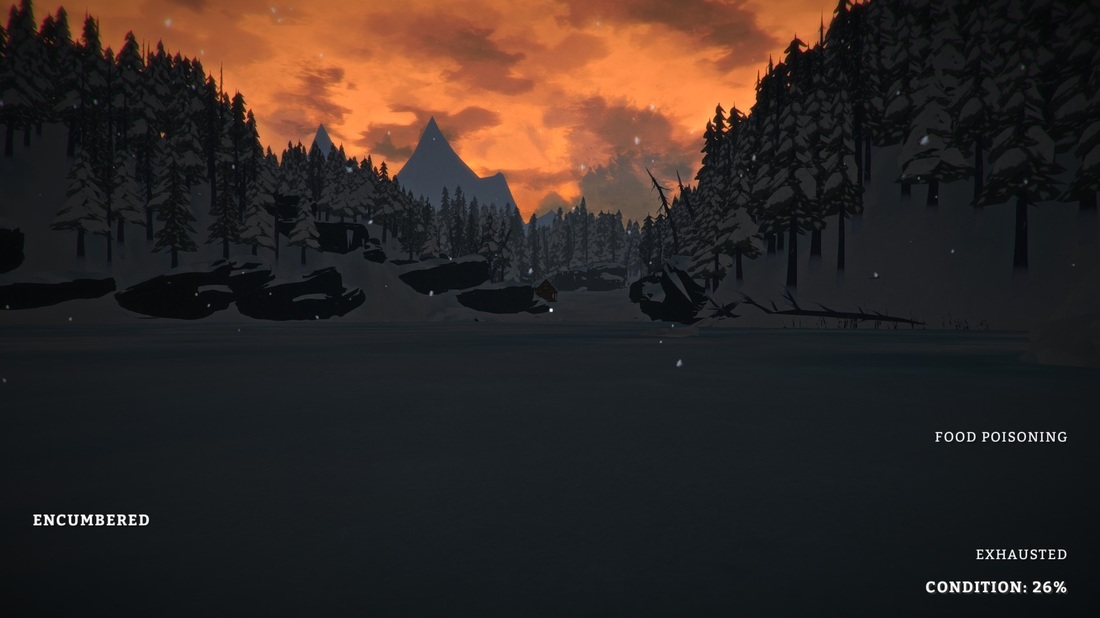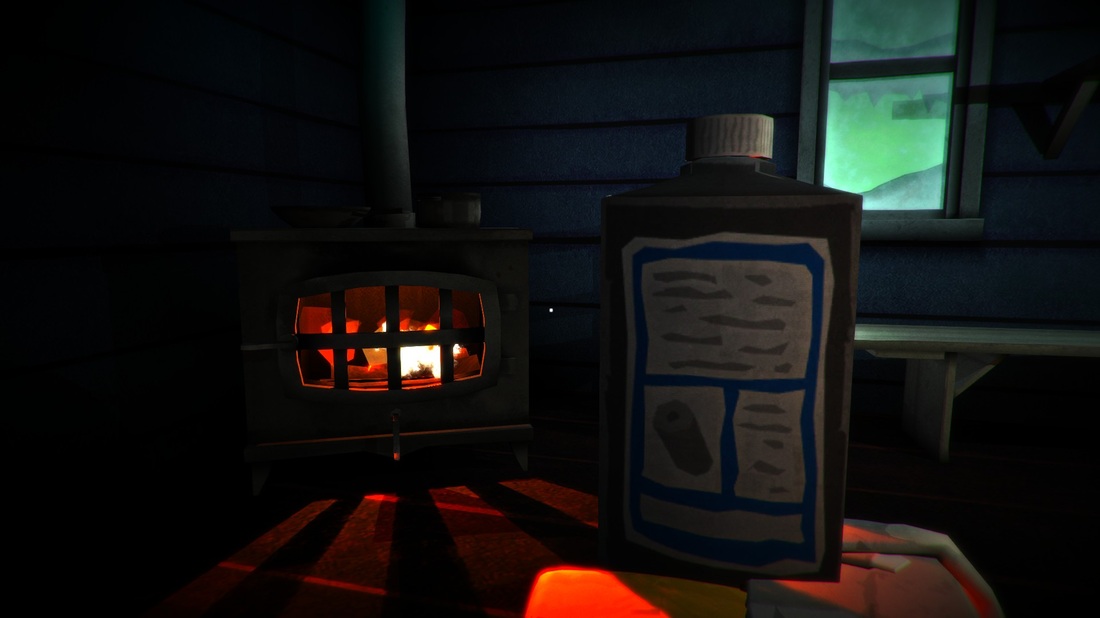Posted by Alex Clippinger
Disclosure: Alex contributed $20 to the game’s Kickstarter campaign last year.
I awaken in a snowbound forest. Okay, I think to myself. It’s a survival game. I need to find shelter, find wood, find food. I look around. I’m surrounded by trees. Nothing but trees. No shelter. Shit. I begin walking, resisting the temptation to sprint as I trudge slowly through the snow. I’m in a gully or small valley of some kind; I follow the contours of the terrain for a few minutes. I still don’t see a shelter. Shit. I’m walking between snowy rocks, I still haven’t found a shelter, and somewhere in the distance a wolf begins to howl. Shit.
I awaken in a snowbound forest. Okay, I think to myself. It’s a survival game. I need to find shelter, find wood, find food. I look around. I’m surrounded by trees. Nothing but trees. No shelter. Shit. I begin walking, resisting the temptation to sprint as I trudge slowly through the snow. I’m in a gully or small valley of some kind; I follow the contours of the terrain for a few minutes. I still don’t see a shelter. Shit. I’m walking between snowy rocks, I still haven’t found a shelter, and somewhere in the distance a wolf begins to howl. Shit.

This was my introduction to The Long Dark’s Alpha-version Sandbox mode. The Long Dark is a stylized survival simulator that swears off the zombie-and-mutant-heavy genre in favor of a purely man-versus-elements experience. This is the first project by independent developer Hinterland Games, a new studio made up of some impressive AAA studio talent. In fact, the entire project has been saturated with professional talent, including their voice actors; Mark Meer and Jennifer Hale of Mass Effect fame voice the male and female sandbox characters, respectively. Meer will voice the game’s main character when its episodic story mode goes live, which will include additional talent such as David Hayter of Metal Gear Solid.
The level of talent is visible in The Long Dark. For a survival simulator that touts its difficulty and relative realism, it was originally odd to me to see it employ such an impressionist, even almost cartoonish, art style. Over the course of my playtime, however, I began to understand and appreciate the reasoning; the style complements the difficulty of identifying objects from a distance, the rough-edged and uniform-white wildness of the terrain, and especially works well with the sandbox mode’s ingame night-and-day and weather cycles. The way visibility drops in a blizzard and the tearing wind is visualized and presented so well in this style is, in a word, remarkable. The game’s lighting system is surprisingly dynamic for its artistic style as well; lanterns, held matches, flares, and fire lighting are all distinct and the textures and shadows transition smoothly between lighting levels and distance. In short, the game’s visual aesthetic is appealing and contains surprising depth. The HUD is unobtrusive, with important status effects in the bottom-right, and occasional reminders of your calorie level (every 500 calories burned) appearing briefly at the bottom-left.
The Long Dark’s sound design, music, and voice acting are superb in this sandbox mode. Howling winds, soft breezes, distant wolf howls, and the steady crunch, crunch, crunch of snow underfoot punctuate an otherwise dead-silent natural world. The current game’s music is minimalist, providing occasional brief compliments to the atmosphere as night falls, night ends, as locations are discovered, and so on.
The voice acting for both the male and female character are contextually appropriate. Your character will make remarks to themselves as they search for supplies, but more importantly they will give you status updates about your character; remarking on how cold they are, how hungry or tired, and so on. Like the music, the voice acting is added for emphasis and doesn’t detract from the experience of exploration and survival.
The game’s mechanics focus on a consistent fight for survival. You spawn in to a random location on the map, and at a random time (one of my playthroughs involved a 3:17am spawn-in with a -24F windchill). The current sandbox map is mostly static, wherein locations are always in the same place but their item spawns, and scattered corpses/backpack locations, are random. Very specific items can always be found in certain locations, but containers and the like are a toss-up about what they will contain, if anything.
Calories are a constant concern. Sleeping burns a small 100 calories an hour, but walking around usually burns a great deal more; experimenting with running while ‘Freezing’ started to burn upwards of 400 calories an hour. Struggling through tough terrain, trying to maximize your efficiency between points of interest, is a scary exercise in personal discipline and resource management. Candy bars and ‘small’ food items grant a measly 150-200 calories per use; canned food gives a few hundred, and the rare MRE, or cooked meat from wild game, gives 1000 calories or greater. The higher the rarity, or the greater the difficulty of acquiring the food item, the better the return by far.
Dehydration can occur, but every time you build a fire you’re given the option of ‘melt snow’ and ‘boil water’ in various amounts to keep up your potable supply. Fires are precious; a few hours of warmth to increase the temperature in your shelter when you sleep is necessary, but you also need to burn through a lot of fuel time (each type of firewood you find adds specific amounts to a fire’s duration) to reliably create potable water or to cook raw meat.
Gathering wood is a ‘wait-esque’ mechanic to pass time, a la Skyrim, with the stipulation that each hour spent searching costs 400 precious calories. Considering that most food cans and jerky packages are only giving 300-350 or so, and that your well-fed calorie level will usually only hover in the 2000’s or so, the action of gathering wood is necessary for surviving cold nights but highly costly to your food reserves.
All items experience a level of ‘wear;’ tools and clothing will degrade rapidly with use. Food will begin to degrade in your inventory, especially raw meat. As food quality drops, you risk food poisoning. As your tools degrade, they risk breaking. You can ‘harvest’ excess items for raw materials to aid in repair and upkeep of clothing and tools, but this takes time and energy and, in the current version, doesn’t feel particularly useful. One of the sandbox buildings contains a ‘Work Bench,’ where you will eventually be able to create new items with appropriate ‘recipies,’ but the bench is inaccessible at this point and crafting feels somewhat incomplete. The degradation of tools is perhaps a little too quick; as some have pointed out, it’s unrealistic to see a prybar drop in durability with each use so dramatically, or to see your (very rare) hunting rifle drop in quality with each shot. Still, it’s likely that expanded crafting and upkeep, and some fine-tuning of item degradation, will make this whole mechanic feel more fleshed-out.
Speaking of food poisoning, I got it twice in a row at one point. It lays you out and causes your ‘Condition’ (kind of like your hitpoints) to drop. At one point, I was so utterly fatigued from the sickness, I had to half-crawl across an entire frozen lake, with night falling, avoiding wolves along the way, watching my Condition drop rapidly, wondering if I’d make it for fall dead before I reached a shelter for the night. It’s grim, slow struggles like this that really made the survival experience of The Long Dark for me.
The voice acting for both the male and female character are contextually appropriate. Your character will make remarks to themselves as they search for supplies, but more importantly they will give you status updates about your character; remarking on how cold they are, how hungry or tired, and so on. Like the music, the voice acting is added for emphasis and doesn’t detract from the experience of exploration and survival.
The game’s mechanics focus on a consistent fight for survival. You spawn in to a random location on the map, and at a random time (one of my playthroughs involved a 3:17am spawn-in with a -24F windchill). The current sandbox map is mostly static, wherein locations are always in the same place but their item spawns, and scattered corpses/backpack locations, are random. Very specific items can always be found in certain locations, but containers and the like are a toss-up about what they will contain, if anything.
Calories are a constant concern. Sleeping burns a small 100 calories an hour, but walking around usually burns a great deal more; experimenting with running while ‘Freezing’ started to burn upwards of 400 calories an hour. Struggling through tough terrain, trying to maximize your efficiency between points of interest, is a scary exercise in personal discipline and resource management. Candy bars and ‘small’ food items grant a measly 150-200 calories per use; canned food gives a few hundred, and the rare MRE, or cooked meat from wild game, gives 1000 calories or greater. The higher the rarity, or the greater the difficulty of acquiring the food item, the better the return by far.
Dehydration can occur, but every time you build a fire you’re given the option of ‘melt snow’ and ‘boil water’ in various amounts to keep up your potable supply. Fires are precious; a few hours of warmth to increase the temperature in your shelter when you sleep is necessary, but you also need to burn through a lot of fuel time (each type of firewood you find adds specific amounts to a fire’s duration) to reliably create potable water or to cook raw meat.
Gathering wood is a ‘wait-esque’ mechanic to pass time, a la Skyrim, with the stipulation that each hour spent searching costs 400 precious calories. Considering that most food cans and jerky packages are only giving 300-350 or so, and that your well-fed calorie level will usually only hover in the 2000’s or so, the action of gathering wood is necessary for surviving cold nights but highly costly to your food reserves.
All items experience a level of ‘wear;’ tools and clothing will degrade rapidly with use. Food will begin to degrade in your inventory, especially raw meat. As food quality drops, you risk food poisoning. As your tools degrade, they risk breaking. You can ‘harvest’ excess items for raw materials to aid in repair and upkeep of clothing and tools, but this takes time and energy and, in the current version, doesn’t feel particularly useful. One of the sandbox buildings contains a ‘Work Bench,’ where you will eventually be able to create new items with appropriate ‘recipies,’ but the bench is inaccessible at this point and crafting feels somewhat incomplete. The degradation of tools is perhaps a little too quick; as some have pointed out, it’s unrealistic to see a prybar drop in durability with each use so dramatically, or to see your (very rare) hunting rifle drop in quality with each shot. Still, it’s likely that expanded crafting and upkeep, and some fine-tuning of item degradation, will make this whole mechanic feel more fleshed-out.
Speaking of food poisoning, I got it twice in a row at one point. It lays you out and causes your ‘Condition’ (kind of like your hitpoints) to drop. At one point, I was so utterly fatigued from the sickness, I had to half-crawl across an entire frozen lake, with night falling, avoiding wolves along the way, watching my Condition drop rapidly, wondering if I’d make it for fall dead before I reached a shelter for the night. It’s grim, slow struggles like this that really made the survival experience of The Long Dark for me.
The game was markedly mostly bug-free for a first-day-release Alpha. Some high-level Kickstarter backers were given pre-Early-Access, and it’s apparent that Hinterland made a strong effort to publish a bug-free experience off the bat. My only experienced bugs involved, at one point, getting frozen in place (not from the cold) and unable to move or take actions, requiring a quick reload. The only other bug involved dropping an item in a cabin and suddenly being confronted by a hilariously large container of lantern fuel.
So, the part you really care about.
Is The Long Dark good? Yes. Is it worth investing in the Early Access? Yes, if the survival sandbox experience appeals to you. If not, wait for the episodic story mode to release and revisit the game. Is the game’s current sandbox worth the price? For twenty dollars, it sure is.
The summary: The Long Dark is currently a visually unique, well-designed survival simulator with good balance and stability off the bat. It has a few weak points, but these are already addressed with planned future content. So unless Hinterland Games suddenly does a complete about-face on its design goals, The Long Dark experience will only improve as time goes on.




